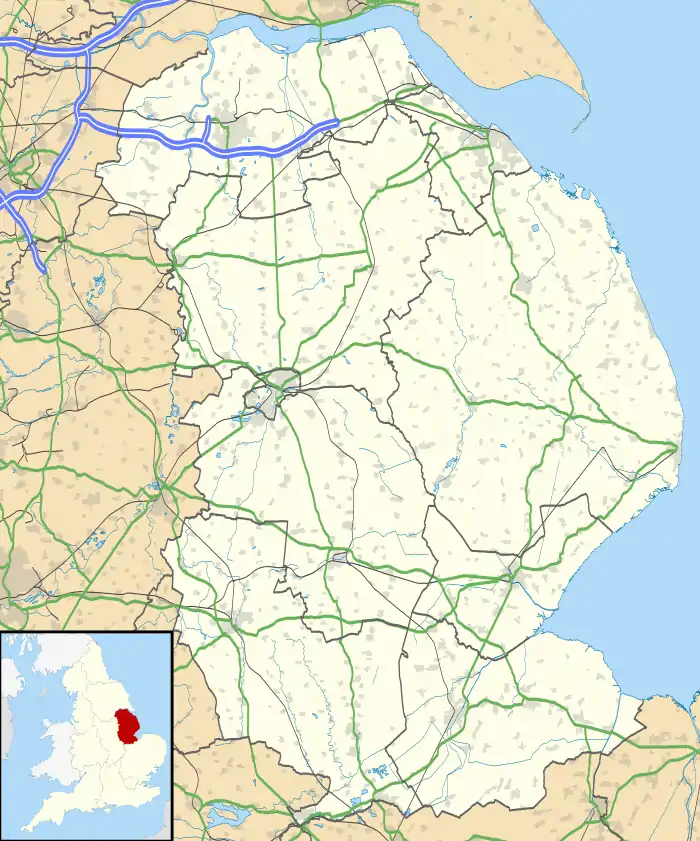Holton le Moor
Holton le Moor is a small village and civil parish in the West Lindsey district of Lincolnshire, England.
| Holton le Moor | |
|---|---|
 St Luke's Church, Holton le Moor | |
 Holton le Moor Location within Lincolnshire | |
| OS grid reference | TF080979 |
| • London | 135 mi (217 km) S |
| District | |
| Shire county | |
| Region | |
| Country | England |
| Sovereign state | United Kingdom |
| Post town | MARKET RASEN |
| Postcode district | LN7 |
| Dialling code | 01673 |
| Police | Lincolnshire |
| Fire | Lincolnshire |
| Ambulance | East Midlands |
| UK Parliament | |
Holton le Moor lies on the B1434 road. The nearest towns are Market Rasen 6 miles (10 km) to the south and Caistor 3 miles (5 km) to the north-east. It was formerly served by Holton Le Moor railway station.
In the Domesday account the village is written as "Hoctune". It was within the manor of Caistor in the then Lindsey North Riding, and prior to the Norman Conquest under the lordship of Earl Morcar. By 1086 the manor had fallen under the lordship of Ivo Taillebois and William I.[1][2]
In 1885 Kelly's noted that the village was in the parish of Caistor, had an 1881 population of 178, and that chief agricultural production of the area was in wheat, barley, oats and turnips.[3]
The Grade II listed Anglican church is dedicated to St Luke.[4] It was re-built in 1854 by a George Place in Early English style, consisting of a chancel, nave, north aisle, and a bell turret with two bells.[3] It was again partly rebuilt in 1926 by H. G. Gamble. The earlier parts of the church are ironstone, the doorway Norman style, and the stoup 13th century.[5] There are memorials to the Dixon family, Lords of the Manor, painted wall decoration in the south chapel and stained glass windows from 1893.[3][4]
Holton Hall was built in 1785 for Thomas Dixon by a local builder, and is listed,[5][6] as are the hall's stables.[7] Other listed structures include a farmhouse,[8] cottages[9] and pigeoncote.[10] In 1964 Pevsner noted the school to the west of the church, built in 1913 by H. G. Gamble, and described it as "Nice, friendly, symmetrical, with large windows, and a steep pediment, decorated with rose branches".[5]
St Luke's infant and junior primary Church of England School was associated with the village church. It closed in August 2006.[11] The oldest remaining structure in the village, the Moot Hall, was built in 1910.[12]
References
- "Holton le Moor" Archived 21 August 2014 at the Wayback Machine, Domesdaymap.co.uk. Retrieved 19 November 2011
- "Documents Online: Holton le Moor", Folio: 352r Great Domesday Book; The National Archives. Retrieved 19 November 2011
- Kelly's Directory of Lincolnshire with the port of Hull 1885, p. 482
- Historic England. "Church of St Luke (1166017)". National Heritage List for England. Retrieved 18 November 2011.
- Pevsner, Nikolaus; Harris, John; The Buildings of England: Lincolnshire p. 275; Penguin, (1964); revised by Nicholas Antram (1989), Yale University Press. ISBN 0-300-09620-8
- Historic England. "Holton Hall (1309110)". National Heritage List for England. Retrieved 18 November 2011.
- Historic England. "Stables at Holton Hall (1359790)". National Heritage List for England. Retrieved 18 November 2011.
- Historic England. "Broughton Farmhouse (1063422)". National Heritage List for England. Retrieved 18 November 2011.
- Historic England. "Yewfield Farm Cottages at Yewfield Farm (1359809)". National Heritage List for England. Retrieved 18 November 2011.
- Historic England. "Pigeoncote at Barkworth Farm (1063463)". National Heritage List for England. Retrieved 18 November 2011.
- "The St Luke's Church of England Primary School, Holton Le Moor". Department for Education. Retrieved 8 April 2023.
- "Welcome to the Moot Hall, Holton le Moor". Retrieved 8 April 2023.
External links
 Media related to Holton le Moor at Wikimedia Commons
Media related to Holton le Moor at Wikimedia Commons- "Holton le Moor", Genuki.org.uk. Retrieved 18 November 2011